+ Open data
Open data
- Basic information
Basic information
| Entry | Database: PDB / ID: 5a6f | |||||||||
|---|---|---|---|---|---|---|---|---|---|---|
| Title | Cryo-EM structure of the Slo2.2 Na-activated K channel | |||||||||
 Components Components |
| |||||||||
 Keywords Keywords | TRANSPORT / ION CHANNEL / POTASSIUM CHANNEL | |||||||||
| Function / homology |  Function and homology information Function and homology informationintracellular sodium-activated potassium channel activity / outward rectifier potassium channel activity / potassium ion transmembrane transport / protein homotetramerization / metal ion binding / plasma membrane Similarity search - Function | |||||||||
| Biological species |  | |||||||||
| Method | ELECTRON MICROSCOPY / single particle reconstruction / cryo EM / Resolution: 4.2 Å | |||||||||
 Authors Authors | Hite, R.K. / Yuan, P. / Li, Z. / Hsuing, Y. / Walz, T. / MacKinnon, R. | |||||||||
 Citation Citation |  Journal: Nature / Year: 2015 Journal: Nature / Year: 2015Title: Cryo-electron microscopy structure of the Slo2.2 Na(+)-activated K(+) channel. Authors: Richard K Hite / Peng Yuan / Zongli Li / Yichun Hsuing / Thomas Walz / Roderick MacKinnon /  Abstract: Na(+)-activated K(+) channels are members of the Slo family of large conductance K(+) channels that are widely expressed in the brain, where their opening regulates neuronal excitability. These ...Na(+)-activated K(+) channels are members of the Slo family of large conductance K(+) channels that are widely expressed in the brain, where their opening regulates neuronal excitability. These channels fulfil a number of biological roles and have intriguing biophysical properties, including conductance levels that are ten times those of most other K(+) channels and gating sensitivity to intracellular Na(+). Here we present the structure of a complete Na(+)-activated K(+) channel, chicken Slo2.2, in the Na(+)-free state, determined by cryo-electron microscopy at a nominal resolution of 4.5 ångströms. The channel is composed of a large cytoplasmic gating ring, in which resides the Na(+)-binding site and a transmembrane domain that closely resembles voltage-gated K(+) channels. In the structure, the cytoplasmic domain adopts a closed conformation and the ion conduction pore is also closed. The structure reveals features that can explain the unusually high conductance of Slo channels and how contraction of the cytoplasmic gating ring closes the pore. | |||||||||
| History |
|
- Structure visualization
Structure visualization
| Movie |
 Movie viewer Movie viewer |
|---|---|
| Structure viewer | Molecule:  Molmil Molmil Jmol/JSmol Jmol/JSmol |
- Downloads & links
Downloads & links
- Download
Download
| PDBx/mmCIF format |  5a6f.cif.gz 5a6f.cif.gz | 219.4 KB | Display |  PDBx/mmCIF format PDBx/mmCIF format |
|---|---|---|---|---|
| PDB format |  pdb5a6f.ent.gz pdb5a6f.ent.gz | 175.9 KB | Display |  PDB format PDB format |
| PDBx/mmJSON format |  5a6f.json.gz 5a6f.json.gz | Tree view |  PDBx/mmJSON format PDBx/mmJSON format | |
| Others |  Other downloads Other downloads |
-Validation report
| Arichive directory |  https://data.pdbj.org/pub/pdb/validation_reports/a6/5a6f https://data.pdbj.org/pub/pdb/validation_reports/a6/5a6f ftp://data.pdbj.org/pub/pdb/validation_reports/a6/5a6f ftp://data.pdbj.org/pub/pdb/validation_reports/a6/5a6f | HTTPS FTP |
|---|
-Related structure data
| Related structure data |  3063MC  3062C  3064C  5a6eC  5a6gC C: citing same article ( M: map data used to model this data |
|---|---|
| Similar structure data |
- Links
Links
- Assembly
Assembly
| Deposited unit | 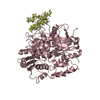
|
|---|---|
| 1 |
|
- Components
Components
| #1: Protein | Mass: 79321.047 Da / Num. of mol.: 1 Source method: isolated from a genetically manipulated source Source: (gene. exp.)   |
|---|---|
| #2: Protein/peptide | Mass: 3677.524 Da / Num. of mol.: 1 Source method: isolated from a genetically manipulated source Source: (gene. exp.)   |
| Sequence details | THE REGISTER OF THE RESIDUES OF CHAIN D SAMPLE SEQUENCE FOR THE ENTRY IS UNKNOWN. HENCE THEY ARE ...THE REGISTER OF THE RESIDUES OF CHAIN D SAMPLE SEQUENCE FOR THE ENTRY IS UNKNOWN. HENCE THEY ARE CHANGED TO UNK. THE SAMPLE SEQUENCE CORRESPOND |
-Experimental details
-Experiment
| Experiment | Method: ELECTRON MICROSCOPY |
|---|---|
| EM experiment | Aggregation state: PARTICLE / 3D reconstruction method: single particle reconstruction |
- Sample preparation
Sample preparation
| Component | Name: SLO2.2 / Type: COMPLEX |
|---|---|
| Buffer solution | Name: 20 MM HEPES, PH 7.4, 300MM KCL, 1.5 MM DODECYL MALTOSIDE, 0.05 MG/ML POPE/POPG (3/1) pH: 7.4 Details: 20 MM HEPES, PH 7.4, 300MM KCL, 1.5 MM DODECYL MALTOSIDE, 0.05 MG/ML POPE/POPG (3/1) |
| Specimen | Conc.: 4 mg/ml / Embedding applied: NO / Shadowing applied: NO / Staining applied: NO / Vitrification applied: YES |
| Specimen support | Details: HOLEY CARBON |
| Vitrification | Instrument: FEI VITROBOT MARK IV / Cryogen name: ETHANE / Details: 84 HUMIDITY 4 SECOND BLOT LIQUID ETHANE |
- Electron microscopy imaging
Electron microscopy imaging
| Experimental equipment |  Model: Titan Krios / Image courtesy: FEI Company |
|---|---|
| Microscopy | Model: FEI TITAN KRIOS / Date: Jul 7, 2014 |
| Electron gun | Electron source:  FIELD EMISSION GUN / Accelerating voltage: 300 kV / Illumination mode: FLOOD BEAM FIELD EMISSION GUN / Accelerating voltage: 300 kV / Illumination mode: FLOOD BEAM |
| Electron lens | Mode: BRIGHT FIELD / Nominal magnification: 105000 X / Calibrated magnification: 105000 X / Nominal defocus max: 4500 nm / Nominal defocus min: 1500 nm / Cs: 2 mm |
| Image recording | Electron dose: 40 e/Å2 / Film or detector model: GATAN K2 (4k x 4k) |
| Image scans | Num. digital images: 2000 |
- Processing
Processing
| CTF correction | Details: EACH IMAGE | ||||||||||||
|---|---|---|---|---|---|---|---|---|---|---|---|---|---|
| Symmetry | Point symmetry: C4 (4 fold cyclic) | ||||||||||||
| 3D reconstruction | Resolution: 4.2 Å / Num. of particles: 24231 / Nominal pixel size: 1.04 Å / Actual pixel size: 1.04 Å Details: SUBMISSION BASED ON EXPERIMENTAL DATA FROM EMDB EMD-3063. (DEPOSITION ID: 13532). Symmetry type: POINT | ||||||||||||
| Atomic model building | Protocol: OTHER / Space: RECIPROCAL / Target criteria: R-factor / Details: REFINEMENT PROTOCOL--EM | ||||||||||||
| Refinement | Highest resolution: 4.2 Å | ||||||||||||
| Refinement step | Cycle: LAST / Highest resolution: 4.2 Å
|
 Movie
Movie Controller
Controller



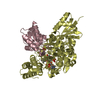
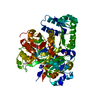
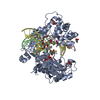
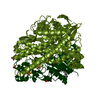
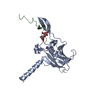
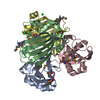
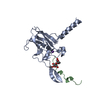
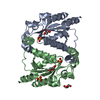
 PDBj
PDBj

